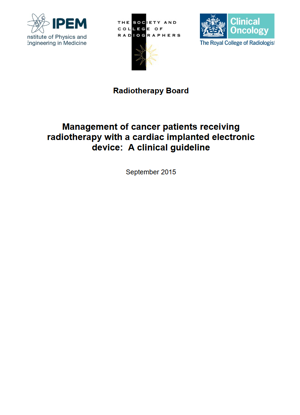Management of cancer patients receiving radiotherapy with a cardiac implanted electronic device
Date: 2015
The number of cancer patients with cardiac implantable electronic devices (CIEDs) receiving radiotherapy is increasing. 2-4 There are two main categories of CIED: permanent pacemakers and implantable cardioverter defibrillators (ICDs). Electronic monitoring devices (eg implantable loop recorders) have no direct connection to the heart and are not covered in this guideline. Most permanent pacemakers (referred to as ‘pacemakers’ in this document) are implanted in patients who either have inappropriate bradycardia, or who are at
risk of bradycardia. Bradycardia pacemakers generally only pace the heart when the patient’s heart rate is excessively slow (usually <50 beats/minute), otherwise the pacemakers simply monitor and therefore an electrocardiogram (ECG) may appear “normal” and not show any pacemaker activity. Cardiac resynchronisation pacemakers coordinate the sequence of cardiac contraction and are used in patients with heart failure. As such, these pacemakers tend to pace the heart continuously and an ECG usually shows paced beats. ICDs are more sophisticated devices; in addition to normal pacing capabilities (for
bradycardia and/or for resynchronisation), ICDs have the ability to monitor the patient’s cardiac rate and rhythm, and deliver shock therapy when certain criteria are met. The simplest shock criteria involve heart rate; thus when sensed heart rate exceeds a pre-programmed value (usually >220 beats/minute), shock therapy is delivered. Inappropriate shock therapy may arise when the ICD senses the cardiac rhythm incorrectly.
